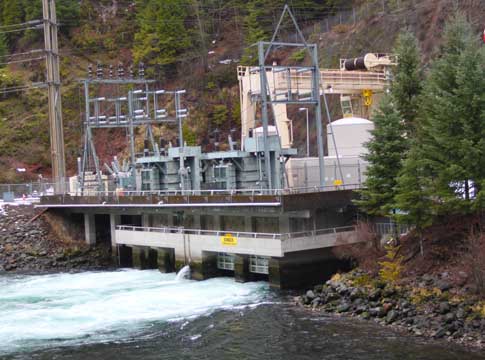The McKenzie River is the lifeblood of Eugene, providing citizens with high quality drinking water and a reliable source of electricity since 1911. EWEB owns and operates two hydroelectric projects on the McKenzie River: the Leaburg/Walterville hydroelectric projects and the Carmen-Smith hydroelectric project.

Carmen Smith Hydroelectric Project
The Carmen-Smith Hydroelectric Project is located 70 miles east of Eugene on the upper McKenzie River. For more than 50 years, Carmen-Smith, our largest utility-owned generating facility, has reliably served our customers with low-cost hydropower. The plant remains valuable as a carbon-free generation resource that can ramp up and down to meet customers' peak energy needs. In other words, the Carmen Smith Project operates as a system to store water overnight, and produces power during high usage times when we would otherwise be buying it on the wholesale market during those more expensive hours.
Carmen-Smith is a network of three dams and reservoirs and two power-generating plants located just a few miles downstream from the headwaters of the McKenzie River.
The Carmen Diversion Reservoir, filled by the McKenzie River flowing from its headwaters at Clear Lake, has minimal storage capacity and is used to divert water into a tunnel leading to Smith Reservoir. From Smith Reservoir, water is routed through a second tunnel to the Carmen Power Plant, which discharges into Trail Bridge Reservoir, and then flows through the Trail Bridge power plant and back into the McKenzie River below Trail Bridge Dam.
Carmen power plant generators combine with a smaller, single generator at the Trail Bridge power plant to produce enough energy to power nearly 16,000 Eugene homes.
In 2019, we received a new 40-year federal operating license. We are in the process of implementing the commitments made in the new license and upgrading our infrastructure and recreational amenities. For more information, go to our relicensing page.
Leaburg/Walterville Hydroelectric Project
The Leaburg/Walterville Hydroelectric Project is actually two hydroelectric projects coupled into a single Federal Energy Regulatory Commission (FERC) license on the lower McKenzie River. The projects are "run-of-the-river" developments, meaning they harness the natural flow and elevation drop of the river to generate electricity.
Leaburg Project
The Leaburg Project, built in 1929, consists of a dam, headworks, fish screen, canal, forebay, power plant, substation, tailrace and tailrace fish barrier.
The Leaburg Dam is a reinforced concrete and steel structure that diverts water into a power canal generate electricity farther downstream at the Leaburg power plant. The dam uses roll gates to control the flow of water into the canal and is equipped with fish ladders to help migratory fish travel upstream. The dam is also a bridge that provides access to the Leaburg trout hatchery, Lloyd Knox Park and several private residences on the river's left bank.
The FERC ordered EWEB to cease generation in October 2018, following observations of increased seepage and internal erosion of the canal embankments. Since the order, the Leaburg Canal has been operating as a stormwater conveyance facility.
EWEB initiated a comprehensive assessment of the entire canal in late 2019 to better understand the level of investment that would be required to ensure safe and reliable operation. The evaluation of the economics, environmental factors, and social impacts led EWEB's publicly-elected Commissioners to vote to permanently decommission the facility on January 3, 2023.
On January 9, 2024, the Leaburg team published their first draft of the Leaburg Decommissioning Action Plan. The plan details how EWEB should navigate the FERC process to amend the license to remove the Leaburg Project, the environmental studies needed to anticipate negative impacts, and the public participation process.
Learn more about decommissioning the Leaburg Hydroelectric Project.
Walterville Development
The Walterville plant includes a headworks with a fish screen, power canal, forebay, penstock, power plant, substation, tailrace, fish barrier, and fish return channel, but does not include a dam. A portion of the water from the McKenzie River is diverted via rock formations known as chevrons into a power canal that originates on the McKenzie River's right bank and flows westerly to the forebay. From the forebay, water flows into the Walterville Powerhouse containing a single turbine connected to a generator.
The annual output at the Walterville power plant is enough energy to power over 5,000 Eugene homes for a year.
For updates on maintenance events on the Walterville Canal, please go to Walterville Canal Updates.
With the decision to decommission the Leaburg Hydroelectric Project, EWEB must determine the future of the Walterville project: whether to separate the project from the Leaburg-Walterville FERC license to continue operating through 2080, or to also decommission the project. Generation staff will pursue a Walterville Hydroelectric Project Strategic Evaluation throughout 2024, to understand the economic, environmental and social impacts of continued operation or decommissioning of the facility.

